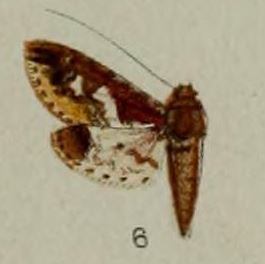Loxmaionia is a genus of moths of the family Crambidae. It contains only one species, Loxmaionia megale, which is found in Costa Rica.

Lophocampa montana is a moth of the family Erebidae. It was described by William Schaus in 1911. It is known from Poás Volcano in Costa Rica.
Anadelosemia senesciella is a species of snout moth. It is found in Costa Rica.
Tithraustes snyderi is a moth of the family Notodontidae. It is found in cloud-forest habitats within La Amistad, an international park extending from south-central Costa Rica into the Chiriqui Province of Panama.

Lophocampa affinis is a moth of the family Erebidae. It was described by Walter Rothschild in 1909. It is found in Mexico.

Idalus paulae is a moth in the family Erebidae. It is found in the Cordillera Volcanica Central, the Cordillera de Talamanca and the Cordillera Talamanca of Costa Rica. The habitat consists of rain forests and the margins of cloud forests, on both the Pacific and Atlantic slopes at altitudes between 1,400 and 2,230 meters.
Episcepsis gnomoides is a moth of the family Erebidae. It was described by William Schaus in 1910. It is found in Costa Rica.
Trichromia phaeocrota is a moth in the family Erebidae. It is found in French Guiana and Venezuela.
Apatelodes quadrata is a moth in the family Apatelodidae first described by E. Dukinfield Jones in 1908. It is found in Paraná, Brazil.
Apilocrocis glaucosia is a moth in the family Crambidae. It was described by George Hampson in 1912. It is found in Panama, Guatemala and Mexico.

Eurrhyparodes syllepidia is a moth in the family Crambidae. It was described by George Hampson in 1898. It is found in Mexico and Costa Rica.
Pilocrocis cyrisalis is a moth in the family Crambidae. It was described by Herbert Druce in 1895. It is found in Panama and Costa Rica.
Praeacrospila patricialis is a moth in the family Crambidae. It was described by William Schaus in 1912. It is found in Costa Rica.
Proleucinodes melanoleuca is a moth in the family Crambidae. It was described by George Hampson in 1913. It is found in Peru.
Pycnarmon leucinodialis is a moth in the family Crambidae described by William Schaus in 1912. It is found in Costa Rica.
Pygospila bivittalis is a moth in the family Crambidae. It was described by Francis Walker in 1866. It is found in India, China, Indonesia, New Guinea and Australia, where it has been recorded from Queensland.
Syngamilyta samarialis is a moth in the family Crambidae. It was described by Herbert Druce in 1899. It is found in Costa Rica and Colombia.
Syntrita nimalis is a moth in the family Crambidae. It was described by William Schaus in 1924. It is found in Bolivia.
Udea ochropera is a moth in the family Crambidae. It was described by George Hampson in 1913. It is found in Colombia and Mexico.
Hypatima corynetis is a species of moth in the family Gelechiidae. It was described by Edward Meyrick in 1913. It is found in Sri Lanka.


